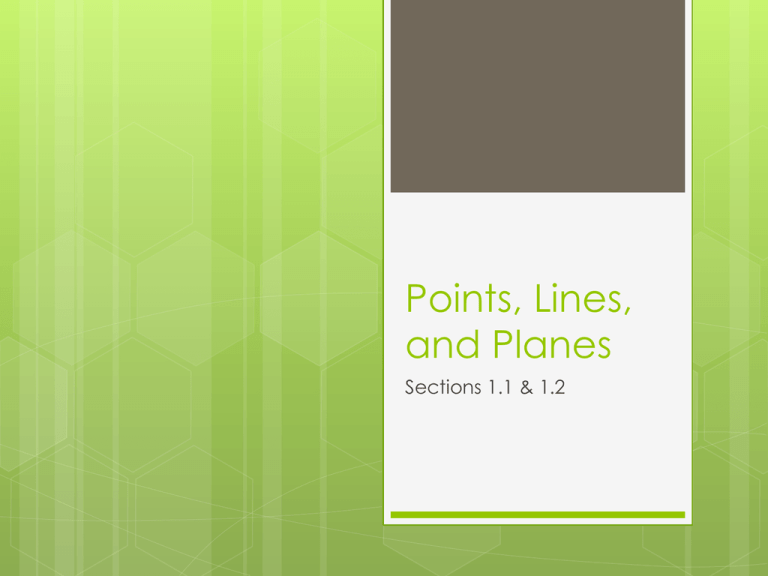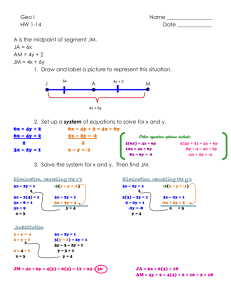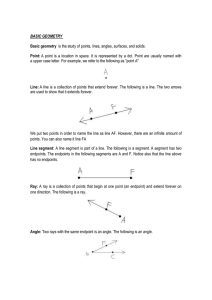Notes
advertisement

Points, Lines, and Planes Sections 1.1 & 1.2 Definition: Point A point has no dimension. It is represented by a dot. A point is symbolized using an upper-case letter. Definition: Line A line has one dimension. (infinite length) Name a line using any 2 points on the line with a two sided arrow above: 𝐴𝐵 Also name by using a lower-case cursive letter. Line l Definition: Plane A plane has 2 dimensions. It is represented by a shape that looks like a parallelogram. It extends infinitely in length and width. Name a plane using the word plane with 3 noncollinear points in the plane. Plane ABC Also name with an upper-case cursive letter. Plane M Definition: Collinear Points Points that lie (or could lie) on the same line. Definition: Coplanar Coplanar points are points that lie (or could lie) in the same plane. Definition: Line Segment A line segment consists of two endpoints and all the points between them. Named using both endpoints with a line segment above like this: 𝐴𝐵. 𝐴𝐵 and 𝐵𝐴 refer to the same line segment. Definition: Ray The ray consists of an endpoint and all points on a line in the opposite direction. A ray is named using its endpoint first and then any other point on the ray with a ray symbol pointing to the right above them like this: 𝐴𝐵. 𝐴𝐵 and 𝐵𝐴 do not refer to the same ray. Definition: Opposite Rays If point C lies on line AB between A and B, then ray CA and ray CB are opposite rays. Two opposite rays make a line. Definition: Intersection The intersection of two or more figures is the set of points the figures have in common. The intersection of 2 different lines is a point. The intersection of 2 different planes is a line. Definition: Postulate A rule that is accepted without proof. Definition: Theorem A rule that can be proven. Definition: Between Between also implies collinear. Definition: Congruent Segments Line segments of equal (=) length are called congruent (≅)segments. To show that two segments are congruent in a drawing we use matching tick marks. A B C D Definition: Distance The distance between points A and B is also known as the length of line segment AB. Distance is how many units apart the points lie. The distance from A to B, or the length of 𝐴𝐵 is symbolized as AB. (No symbol above). Distance Formula The distance formula is used to compute the distance between two points in a coordinate plane. It is given by: d ( x2 x1 ) ( y2 y1 ) 2 2 Finding the Distance Find the distance between the points (1, 4) and (-2, 8). Alternative to the Distance Formula The distance formula comes from the Pythagorean theorem: a2 + b2 = c2 If you are unsure about the distance formula, graph the two points accurately on a graph and use the Pythagorean theorem to find the distance. Finding distance Find the distance between (-2, 3) & (10, 8) by graphing and using the Pythagorean theorem. Compare the two ways Find the distance between (-7, -3) & (8, 5) using the distance formula. Graph the same two points and find the distance using the Pythagorean Theorem. Segment Addition Postulate If B is between A and C, then AB + BC = AC. If AB + BC = AC, then B is between A and C. Definition: Midpoint The midpoint of a segment is the point that divides the segment into two congruent pieces. Midpoint Formula The coordinates of the midpoint of a segment are the averages of the xcoordinates and of the y-coordinates of the endpoints. x1 x2 y1 y2 M , 2 2 Finding a Midpoint Find the midpoint between the endpoints (1, 7) & (3, -4). Find the midpoint between the endpoints (2, 5) & (-3, 9) Finding an Endpoint If the midpoint of segment AB is (2, 3) and A is at (-1, 5), where is B located? If the midpoint of segment CD is (0, 2) and D is at (3, 4), where is C located? Definition: Segment Bisector A segment bisector is a point, ray, line, line segment, or plane, that intersects the segment at its midpoint. Definition: Angle Formed by two different rays with the same endpoint called the vertex. An angle is named using ∠ and 1) three points with the vertex in middle 2) just the vertex iff no other angle has the same vertex 3) a number assigned to the angle Definition: Measure of an angle To denote the measure of an angle, we write an “m” in front of the angle sign: m∠𝐴𝐵𝐶 = 90o Definitions: Angles Classified by Measure An acute angle has a measure between 0o and 90o A right angle has a measure of exactly 90o An obtuse angle has a measure between 90o and 180o A straight angle has a measure of 180o Angle Addition Postulate The measures of two adjacent angles can be added to represent the large angle they form. Definition: Angle Bisector An angle bisector is a ray that divides one angle into two congruent angles. Definition: Congruent Angles Two angle are congruent if they have the same measure. To show that two angles in a diagram are congruent, we put a matching arc inside each angle. Definition: Complementary Angles Two angles whose measures sum to 90° Definition: Supplementary Angles Two angles whose measures sum to180o. Definition: Adjacent Angles Two angles that share a common vertex and side, but have no common interior points. Definition: Linear Pair Two adjacent angles whose sides form a straight line. The angles in a linear pair are always supplementary . Definition: Vertical Angle Pairs Formed when two lines intersect. The angle pairs only touch at the vertex. There are two pairs of vertical angles formed whenever two lines intersect.





